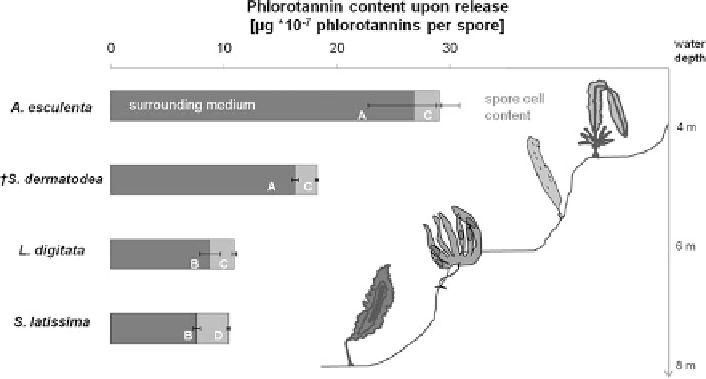Biology Reference
In-Depth Information
Fig. 20.2
Collection depth of
Alaria esculenta, Saccorhiza dermatodea
[
data from Steinhoff
et al. (
2011b
)],
Laminaria digitata,
and
Saccharina latissima
from Kongsfjorden, Spitsbergen in
correlation with the sum of phlorotannin content [
m
g
10
7
phlorotannin spore
1
] within the
surrounding medium and the zoospores. Vertical zonation of sublittoral Arctic brown algae species
reflects parental phlorotannin content liberated upon spore release.
Capital letters
indicate statis-
tical differences (
p
<
0.05) and vertical bars standard deviation (
n ¼
3). Steinhoff et al. previ-
ously unpublished
{
Consequently, cellular protection against harmful UVB is particularly vital for
the microscopic reproductive stages of seaweeds. Studies on brown algal spores
under elevated radiation scenarios suggest that phlorotannins are highly variable
due to inter- and intraspecific variations (Toth et al.
2005
; Connan et al.
2006
),
developmental stage (van Alstyne et al.
2001
), habitat (Hemmi and Jormalainen
2004
), and season (Plouguern´ et al.
2006
). Likewise are the multiple roles and
tasks of phlorotannins within different species and their developmental stages very
likely to be determined by interaction of a variety of biotic and abiotic factors
(Pavia et al.
1997
). The vertical zonation pattern of the parental algae seems to be
coupled with the amount of exuded phlorotannins, with high amounts of released
phlorotannins in species and specimens from the upper sublittoral compared to
individuals from the lower sublittoral (Fig.
20.2
, Steinhoff et al. unpublished,
Wiencke et al.
2006
). The induction of phlorotannins (Pavia et al.
1997
) is most
likely time dependent; a significant phlorotannin formation at mid-term scales (i.e.,
10 days) within macroalgal juveniles of
S. latissima
and
A. esculenta
(Steinhoff
et al.
2011a
) could be detected while it is lacking on short-term (i.e., 8 h) scales
(M
uller et al.
2009
; Steinhoff et al.
2011b
). Parental efforts and the respective
conditioning of parental seaweeds toward the respective UV exposure at the natural
growth site seem to play a major role to increase viability of the offspring by
“transferring” the acquired UVR tolerances to their reproductive stages (Steinhoff
et al.
2011b
).
€

